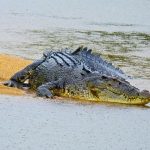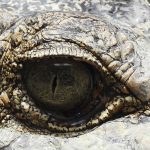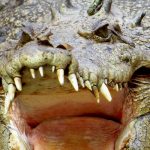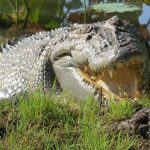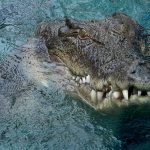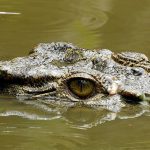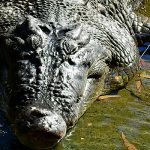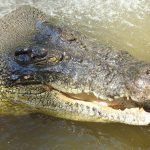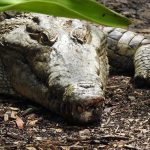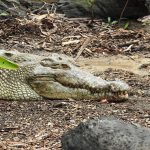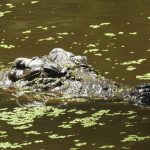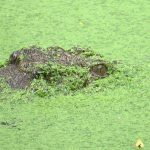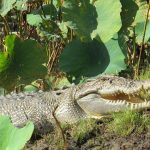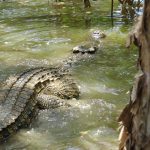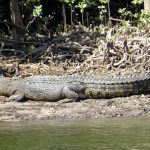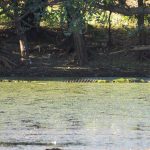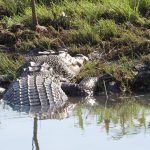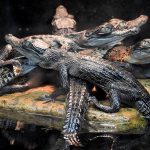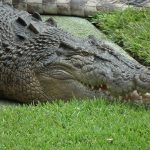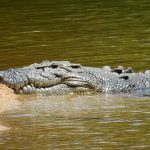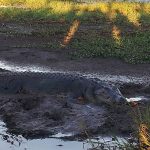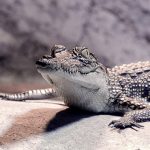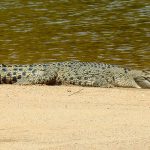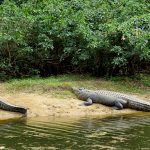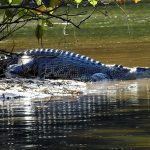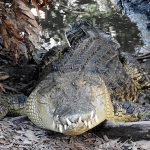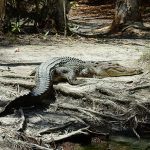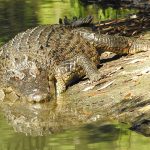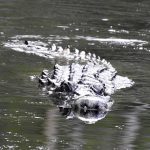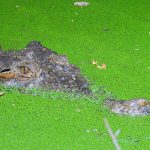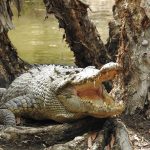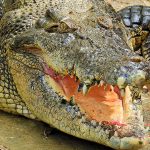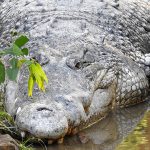SALTWATER CROCODILE
Sharon: This video shows the Saltwater Crocodiles that we encountered along one of North Queensland’s River systems. Accompanied by our son, Jesse, who knew every Croc in the river.
Journey to the Realm of the Saltwater Crocodile
Let me take you on a journey to the northern stretches of Australia, where the rivers, estuaries, and coastal waters are the domain of an ancient and formidable reptile—the Saltwater crocodile.
Dawn on the Mangrove Estuary
Picture this: the sun is just peeking over the horizon, casting a golden glow over the tranquil waters of a mangrove-lined estuary. The air is cool and tinged with the earthy scent of wet mud and sea breeze. Birdsong echoes through the trees, and the gentle lapping of water creates a sense of peace. It’s a serene Australian dawn—until you notice a pair of eyes just above the waterline, gliding silently along the surface. This is the Saltwater crocodile, the largest living reptile on our planet and a true icon of Australia’s wild north.
The Living Fossil
Saltwater crocodiles are remarkable creatures that have roamed the Earth for millions of years, virtually unchanged. They are apex predators, meaning they sit at the top of the food chain, with no natural predators once they reach adulthood. Their presence is felt not only through their impressive physical form but also in the silent power they exude, moving with a stillness that belies their explosive energy.
Key Features
- Size and Strength: A Saltwater crocodile can grow to lengths exceeding 6 metres, with some reports of individuals reaching up to 7 metres.
- Physical Adaptations: Their robust body, thick armoured skin, and powerful jaws are equipped with an arsenal of conical teeth designed to grip and hold onto their prey with devastating force.
- Senses: Their sensory organs—eyes, ears, and nostrils—are positioned on top of their head, allowing them to remain almost entirely submerged while keeping watch over their surroundings.
Masters of Land and Sea
But it’s not just their size and strength that make saltwater crocodiles fascinating. They are renowned for their complex behaviours and remarkable adaptability:
- Agility: Despite their bulk, saltwater crocodiles are surprisingly agile. A sudden flick of their muscular tail can send them hurtling through the water at speeds up to 29 kilometres per hour in short bursts.
- Navigation: These crocodiles are excellent navigators, capable of travelling long distances across open sea to find new territories or mates, using both ocean currents and celestial cues.
- Behaviour: They exhibit a range of social behaviours, from establishing territories to precision timing during nesting and hunting.
The Crocodile’s Role in the Ecosystem
Saltwater crocodiles are key players in their ecosystem, contributing to the health and balance of their environment.
| Role | Impact |
|---|---|
| Predator | Control populations of fish, birds, and mammals, preventing overgrazing |
| Nest Builder | Nests provide microhabitats for insects and other species |
| Food Web Contributor | Unhatched eggs and young become food for a variety of predators |
Every movement, from their stealthy glide beneath the water to the thunderous snap of their jaws, echoes through the food web, shaping the lives of countless other species.
A Story of Survival and Conservation
However, these mighty reptiles haven’t always had an easy time. In the mid-20th century, Saltwater crocodiles were hunted to the brink of extinction for their hides, coveted in the global leather trade. By the 1970s, their numbers had plummeted dangerously low, and it appeared that this ancient lineage might vanish from Australia’s wild places.
It was not until strong legal protections were introduced that their fortunes began to change. The Australian government recognised the ecological importance of these crocodiles, implementing strict conservation measures. Today, Saltwater crocodiles are a protected species, and their resurgence is considered a triumph of wildlife management—a powerful reminder of how timely intervention can reverse the tide of extinction.
Living with Crocodiles
Despite their recovery, Saltwater crocodiles can be a source of conflict with humans, particularly where towns, farms, and industries encroach on their natural habitats.
Safety and Respect
- Be Croc-Wise: Always heed local warnings and safety guidelines when near crocodile habitats.
- Distance: Maintain a respectful distance and never attempt to feed or approach wild crocodiles.
- Coexistence: Understanding crocodile behaviour and respecting their space is essential for both human safety and the continued survival of these remarkable animals.
The Saltwater Crocodile’s Legacy
The story of the Saltwater crocodile is one of resilience and adaptation—an ancient creature navigating the challenges of a changing world. Their continued presence is a living reminder of Australia’s wild heritage, and the delicate balance that exists between nature and human progress.
By respecting these extraordinary animals and safeguarding the ecosystems they depend on, we help preserve not just a species, but a vital thread in the intricate fabric of life. In doing so, we ensure that future generations can experience the awe of seeing those prehistoric eyes gliding through the golden dawn—a powerful symbol of nature’s enduring strength and beauty.

